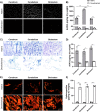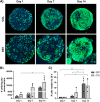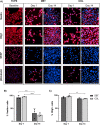Development of Brain-Derived Bioscaffolds for Neural Progenitor Cell Culture
- PMID: 36798475
- PMCID: PMC9926525
- DOI: 10.1021/acsptsci.2c00232
Development of Brain-Derived Bioscaffolds for Neural Progenitor Cell Culture
Abstract
Biomaterials derived from brain extracellular matrix (ECM) have the potential to promote neural tissue regeneration by providing instructive cues that can direct cell survival, proliferation, and differentiation. This study focused on the development and characterization of microcarriers derived from decellularized brain tissue (DBT) as a platform for neural progenitor cell culture. First, a novel detergent-free decellularization protocol was established that effectively reduced the cellular content of porcine and rat brains, with a >97% decrease in the dsDNA content, while preserving collagens (COLs) and glycosaminoglycans (GAGs). Next, electrospraying methods were applied to generate ECM-derived microcarriers incorporating the porcine DBT that were stable without chemical cross-linking, along with control microcarriers fabricated from commercially sourced bovine tendon COL. The DBT microcarriers were structurally and biomechanically similar to the COL microcarriers, but compositionally distinct, containing a broader range of COL types and higher sulfated GAG content. Finally, we compared the growth, phenotype, and neurotrophic factor gene expression levels of rat brain-derived progenitor cells (BDPCs) cultured on the DBT or COL microcarriers within spinner flask bioreactors over 2 weeks. Both microcarrier types supported BDPC attachment and expansion, with immunofluorescence staining results suggesting that the culture conditions promoted BDPC differentiation toward the oligodendrocyte lineage, which may be favorable for cell therapies targeting remyelination. Overall, our findings support the further investigation of the ECM-derived microcarriers as a platform for neural cell derivation for applications in regenerative medicine.
© 2023 American Chemical Society.
Conflict of interest statement
The authors declare no competing financial interest.
Figures









Similar articles
-
Probing the effects of matrix-derived microcarrier composition on human adipose-derived stromal cells cultured dynamically within spinner flask bioreactors.J Biomed Mater Res A. 2023 Mar;111(3):415-434. doi: 10.1002/jbm.a.37459. Epub 2022 Oct 10. J Biomed Mater Res A. 2023. PMID: 36210786
-
A Simple, Cost-Effective Microfluidic Device Using a 3D Cross-Flow T-Junction for Producing Decellularized Extracellular Matrix-Derived Microcarriers.J Biomed Mater Res A. 2025 Feb;113(2):e37873. doi: 10.1002/jbm.a.37873. J Biomed Mater Res A. 2025. PMID: 39943778
-
Development of 2-D and 3-D culture platforms derived from decellularized nucleus pulposus.Front Bioeng Biotechnol. 2022 Sep 27;10:937239. doi: 10.3389/fbioe.2022.937239. eCollection 2022. Front Bioeng Biotechnol. 2022. PMID: 36237211 Free PMC article.
-
Development and characterization of matrix-derived microcarriers from decellularized tissues using electrospraying techniques.J Biomed Mater Res A. 2022 Mar;110(3):559-575. doi: 10.1002/jbm.a.37306. Epub 2021 Sep 28. J Biomed Mater Res A. 2022. PMID: 34581474
-
Decellularized adipose tissue microcarriers as a dynamic culture platform for human adipose-derived stem/stromal cell expansion.Biomaterials. 2017 Mar;120:66-80. doi: 10.1016/j.biomaterials.2016.12.017. Epub 2016 Dec 23. Biomaterials. 2017. PMID: 28038353
Cited by
-
Leveraging Biomaterial Platforms to Study Aging-Related Neural and Muscular Degeneration.Biomolecules. 2024 Jan 4;14(1):69. doi: 10.3390/biom14010069. Biomolecules. 2024. PMID: 38254669 Free PMC article. Review.
-
Research Progress on the Preparation and Application of Decellularized Tendons.Curr Issues Mol Biol. 2025 Apr 6;47(4):251. doi: 10.3390/cimb47040251. Curr Issues Mol Biol. 2025. PMID: 40699650 Free PMC article. Review.
-
Generation of decellularized human brain tissue for investigating cell-matrix interactions: a proof-of-concept study.Front Bioeng Biotechnol. 2025 Jun 5;13:1578467. doi: 10.3389/fbioe.2025.1578467. eCollection 2025. Front Bioeng Biotechnol. 2025. PMID: 40539096 Free PMC article.
References
-
- Mirahmadi M.; Rezanejadbardaji H.; Irfan-Maqsood M.; Mokhtari M. J.; Naderi-Meshkin H. Stem Cell Therapy for Neurodegenerative Diseases: Strategies for Regeneration against Degeneration. J. Genes Cells 2017, 3, 22.10.15562/gnc.54. - DOI
LinkOut - more resources
Full Text Sources
Other Literature Sources
